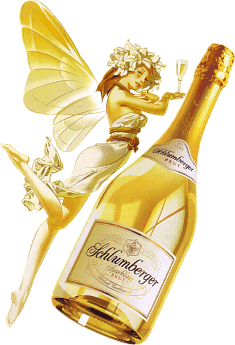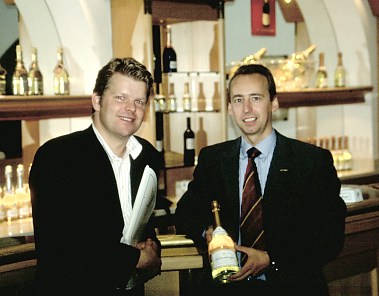|
 |
|
| American Dream Wine |
|
Schlumberger
Extra Brut
1996 Vintages receives |
|

Extraordinaire |
|

The Ultimate Award:
Seven
Stars and Stripes ™ |
|
| Near to the city
center on Heiligenstädter Straße 43 not far from
the beautiful blue Danube River, we had been invited by winery
manager Peter Höller to discover the cellars and sample
the fine products of the Schlumberger Sektkellerei. |
|
|
|
Champagne
- Made in Austria
After this first glimpse into the rich history of the capital of Austria
we were keen to explore another diamond of Viennese lifestyle - The Schlumberger
Winery. While we had our first opportunity to taste the Cuveé Klimt
in the City Tavern in Philadelphia we were keen to follow the Schlumberger
history with its unique roots to Reims in France the heart of the Champagne.
We were told that the founder Robert Schlumberger, an Aristocrat from Goldeck,
began his career in Reims (France) at the oldest Champagne Cellar Ruinart
Père et Fils. After returning to Vienna and grounding Schlumberger
in 1842, he started to produce sparkling wine according to the traditional
‘Méthode Champenoise’, the knowledge of which he had acquired
while in France. "A row of experiments using Austrian wine brought us to
realize that it would be possible to produce sparkling wine in such a manner
that it could truly compete with Champagne.” (Robert Schlumberger)
|
|
 |
|
The special selection of Austrian
wines and the use of the “Méthode Traditionnelle”
guarantees a high level of agreeability. At Schlumberger, close attention
is paid to ensuring the highest quality. Beginning already with the
careful selection of the grapes, the comprehensive quality management
system has led Schlumberger to be the first certified Sparkling winery
(ISO 9002) in the German-speaking world. Since 1994, Schlumberger
has been able to boast this accomplishment.
During our well-presented tour through the Wine Cellar, which allows
you to walk for several miles under the city of Vienna; we were deeply
impressed by the effort behind the production of the top of Austrian
Sparkling Wines.
The making of the Cuvée, or blending (French-Assemblage), of
the various wines and vintages requires much experience from the vintners
and the oenologists. |
|
|
The goal is, of course, to ensure
Schlumberger a high standard of quality and achieve the unique individual
taste that the consumer recognizes by blending exactly the right amounts
of the wine varieties. By fortifying the Cuvée with liqueur de ‘tirage’
and selected yeasts, for which Schlumberger has a patent to use, the wine
goes through a second fermentation. The selected yeast causes important
side effects during the aging process and positively influences the aroma.
The Cuvées are now filled into the bottles and the second fermentation
begins, in which the yeast and sugar eventually change to alcohol and carbon
dioxide. |
|
 |
|
| The bottles are then stored in the
kilometer-long vaults at a constant temperature of 11° Celsius for at
least 18 months. The Cuvée matures and the Schlumberger achieves
the unmistakeable bouquet and mousseux. |
|
Once the shaking is completed, the
yeast settles on the cork. The sparkling wine is now crystal clear
and pure. From now on, the bottles will be stored upside-down.
The sparkling wine is now on its way to being completed.
The bottles are racked, meaning that they are taken from the riddling
area and stored closely together upside-down.
They will remain this way until it is time for the next step. |
|
 |
|
There is punt on the
bottom of the bottle, which is an indentation that helps keep the
cork in the bottle.
The next step, after the fermentation in the bottle, shaking, and
racking, is the step of disgorging.
This is a process only used in the “Méthode Traditionnelle”.
The neck of the bottle is placed upside-down into an ice bath for
several minutes until the yeast sediment (lees) clumps. Utilizing
the pressure of the sparkling wine, the lees is spun out of the bottle.
|
|
|
| The clear wine begins
to foam, as perhaps expected, but not out of the bottle, since the carbon-dioxide
is molecularly bound due to the low temperature. The sparkling wine is freed
of the lees particles and it now crystal clear. |
|
Within the 24 days of bottle fermentation
the "Kellermeister" manually has to turn 30.000 - 40.000 bottles each
day.
Each bottle has a little white mark on its bottom, which indicates
the progress of the turning process inch by inch. |
|
 |
|
|
| After the disgorging process, dosage
liqueur is added to the sparkling wine. This determines the sweetness (e.g.
dry, semi-dry) of the Schlumberger. The dosage consists of wine and sugar.
The level of sugar determines the taste. Dry sparkling (Extra Brut) contains
no dosage. The exact composition of the dosage is a well-kept secret of
Schlumberger. |
|
 |
|
The Schlumberger Wine Selection:
Schlumberger Sparkling Brut
Grape variety: Welschriesling
Schlumberger Extra Brut 1996 Vintage
Grape variety: Welschriesling
Schlumberger Sparkling Brut 1998 Vintage
Grape variety: Welschriesling
Schlumberger Chardonnay 1998 Vintage
Grape Variety: Chardonnay
Schlumberger Blanc de Noirs
Grape Variety: Blauer Burgunder (Pinot Noir)
Schlumberger Cuvée Klimt
Grape variety: Welschriesling
Schlumberger Rosé 1998 Vintage
Grape variety: Blauer Burgunder |
|
|
| We are convinced that a process
this unique, which produces a wine of such a high caliber, will announce
its presence to the world in a fashion consistent with the greatest champagnes
now on the market. Schlumberger is reaching for the stars, one bottle at
a time! |
|
| |
|
Servus Austria !
Rolf Stähler & John Lomitola
Editor-in-Chief: Ingrid Lemme
|
|
